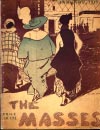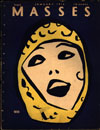Browse Digital Collections
The Masses Digital Collection
With the appearance in America of The Masses in 1911, a new alliance was formed between art and politics. Originally established as an earnest but ultimately dull socialist magazine, The Masses was taken over in 1912 by artists whose commitment to a new artistic age was only equalled by their support of socialist political causes. Modeled after the lavishly illustrated European satiric journals, Simplicissimus and L'Assiette au Beurre, the artists hired Max Eastman as editor who moved the magazine away from socialist "dogma" toward a more far-ranging program condemning racism, supporting women's rights, and promoting the work of a galaxy of writers and thinkers, including John Dewey, Carl Sandburg, Amy Lowell, John Reed, and Sherwood Anderson.
The Masses was particularly noted for its art. As official art editor, John Sloan designed the layout and worked with printers to reproduce vivid two color covers and heavy black crayon drawings. The magazine attracted a number of urban realists who later became known as the Ashcan School (George Bellows, Stuart Davis, Glen Coleman and others); their drawings sought to offer raw appearing glimpses of the lower classes in daily life and in moments of crisis. Unlike nineteenth century American prints which typed the poor as coarse or pathetic, these images were drawn from life. Rather than neat and finished, the style look invitingly incomplete. The Masses also printed political cartoons, social satire, and figure studies and landscapes with no overt political message by artists Robert Minor, Art Young, Maurice Becker, and Boardman Robinson among others.
After running afoul of the Postmaster General, The Masses folded in 1918, replaced by The Liberator (1918-1924). Despite its short existence, The Masses continues to inspire. As one observer has noted, "Art looked artless, an avant garde provocation to the existing art world as well as an invitation to the readers to look at the society around them." This exhibit of selected cover illustrations recognizes the ongoing spirit and importance of this radical magazine.
The Masses Collection at Michigan State University
Now over 75 years old and printed on inexpensive, highly-acidic paper, The Masses has not aged well as a physical artifact. In fact, few original paper copies remain anywhere, including those in the American Radicalism Collection. In 1998, steps were taken to mend and preserve these copies to ensure their existence for future study and use. The preservation process included disbinding, deacidification, mending torn pages, and improved housing. Here are some examples of the newly restored magazine.
| Thumbnail Image | Title | Publisher | Author | Call Number | Description | Available Format(s) |
|---|---|---|---|---|---|---|

|
The Masses 1913
|
unknown or unavailable
|
Author Unknown
|
unknown or unavailable
|
||

|
The Masses 1914
|
unknown or unavailable
|
Author Unknown
|
unknown or unavailable
|
||

|
The Masses 1915
|
unknown or unavailable
|
Author Unknown
|
unknown or unavailable
|
||

|
The Masses 1916
|
unknown or unavailable
|
Author Unknown
|
unknown or unavailable
|
||

|
The Masses 1917
|
unknown or unavailable
|
Author Unknown
|
unknown or unavailable
|
